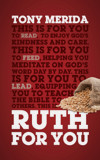
A short while ago I announced to my church that we were going to study Ruth as our church’s Advent series. Several people cheered! We are not an overly expressive church, and so this vocal celebration struck me. Why are Bible readers so drawn to the book of Ruth?
For starters, Ruth is one of the best short stories ever written. Who doesn’t love a good story? “Once upon a time” and “They all lived happily ever after” are phrases cherished by many. Ruth possesses all the elements of a well-written story. We are drawn to the characters: grieving Naomi, loyal Ruth, and compassionate Boaz. The setting is also intriguing. It takes place during the time of the judges (Ruth 1:1); and the locations include Bethlehem, Moab, Boaz’s field, a threshing floor, a city gate, and a bedroom. The plot involves a story of redemption which, as we learn, is part of the grand story of redemption (4:17-20). Naomi stands in the middle of the conflict of the book, as a widow with no son to carry on the family’s line. At the heart of the resolution is Boaz, a figure who shows a lot of similarities to David’s greatest son, Jesus.

Applied expository Bible-study guide on the book of Ruth: a story of redemption that points us to Jesus.
The love story between Ruth and Boaz is remarkable. Like many love stories through the years, two unlikely people unite. Think of other stories you know: a young woman and a terrifying monster in Beauty and the Beast; a failed nun and a military captain in The Sound of Music; a roughneck cowboy and a classy nurse in Open Range; a stager and an Irish innkeeper in Leap Year; and a human and a vampire in Twilight! If you like these sorts of stories, then welcome to Ruth. Here, two very unlikely people get together—an Israelite gentleman and a Moabite widow—and she ends up being one of the many-times-great-grandmothers of Jesus.
As well as the fact that it’s a beautifully written love story, there are many other reasons to study Ruth.
Paul tells us that all of Scripture is “profitable” (2 Timothy 3:16, NIV), and that includes the book of Ruth. While Ruth may be like several popular love stories, it is most certainly unlike them all in this regard: it is “God-breathed” Scripture. We, the people of God, do not live by bread alone, but by every word that proceeds from the mouth of God (Matthew 4:4), and therefore we need the book of Ruth for our own spiritual nourishment.
God has given us his whole word—all 66 books—as one large story. The Bible begins as a story—“In the beginning, God created the heavens and the earth” (Genesis 1:1)—and it ends as a story in the book of Revelation, albeit with a surprising type of ending (for the end is a new beginning!). The Bible does not come to us as a systematic theology book, as important as these books are. Theology books are written topically and aim to explain various doctrines. But the Bible is a story, and all its little stories fit into the larger story. The Bible really is a unified book of redemptive history, of which Jesus is the hero. We therefore need to study individual stories on their own, while keeping the big picture in mind, in order to discern how the little story contributes to this overarching story. Ruth advances the story of God’s redeeming grace to Adam’s fallen race. It magnifies God’s hesed—his covenantal faithfulness and unceasing kindness.
We have real-life details of real-life situations in the lives of real-life characters. To paraphrase the hip hop group Beautiful Eulogy, most of us live in the book of Ruth, not in the book of Exodus! That is, we do not gather manna from heaven every morning and walk through parted seas. We live by faith in God’s “ordinary providence.” There are no miracles in Ruth, but that does not mean God is inactive. We must never assume that a lack of miracles means God is not at work. He is present in the lives of these seemingly insignificant characters, displaying his meticulous providence, just as he is at work in our own lives. Our God is working out all things according to the counsel of his will (Ephesians 1:11), and he is worthy of our trust and adoration.
The gospel is not for Jewish people only but for the whole world, including Moabites like Ruth. God not only allows Ruth to become part of his people but actually uses her as a vital part of his plan. He brings this non-Israelite right into the heart of his people and gives her a place of honor. We need to remember this. Reading Ruth should help us to understand and reflect God’s heart for the nations in our own lives and ministries.
Many Old Testament characters provide us with examples for godly living, and such is the case here. Ruth inspires us to be loyal, sincere, gracious, courageous, and devoted. Boaz gives us a model of manhood: justice-pursuing and not passive, compassionate and not abusive. Naomi’s story engenders hope in us, as she goes from emptiness to fullness in the narrative. We are thus instructed and encouraged by what has been written in these former times (Romans 15:4).
Tony Merida's compelling story-telling and Christ-centered insights make Ruth For You an accessible and absorbing expository guide to the book of Ruth. It can be used for personal devotions, or for leading small-group studies, or for sermon preparation.